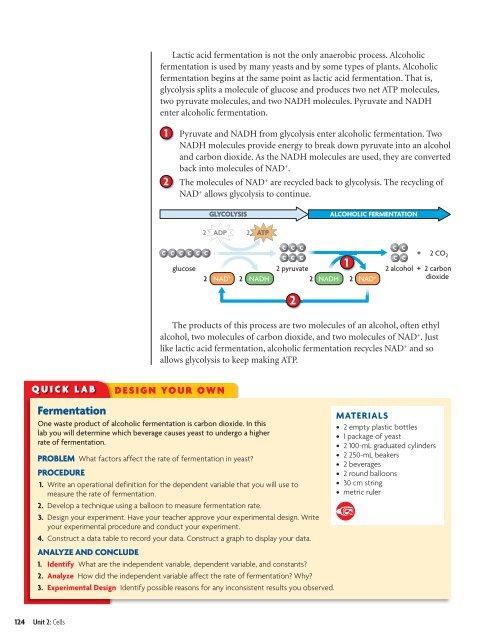Cells and Energy
Cells and Energy
Cells and Energy
You also want an ePaper? Increase the reach of your titles
YUMPU automatically turns print PDFs into web optimized ePapers that Google loves.
Lactic acid fermentation is not the only anaerobic process. Alcoholicfermentation is used by many yeasts <strong>and</strong> by some types of plants. Alcoholicfermentation begins at the same point as lactic acid fermentation. That is,glycolysis splits a molecule of glucose <strong>and</strong> produces two net ATP molecules,two pyruvate molecules, <strong>and</strong> two NADH molecules. Pyruvate <strong>and</strong> NADHenter alcoholic fermentation.1 Pyruvate <strong>and</strong> NADH from glycolysis enter alcoholic fermentation. TwoNADH molecules provide energy to break down pyruvate into an alcohol<strong>and</strong> carbon dioxide. As the NADH molecules are used, they are convertedback into molecules of NAD + .2 The molecules of NAD + are recycled back to glycolysis. The recycling ofNAD + allows glycolysis to continue.GLYCOLYSISALCOHOLIC FERMENTATION 1 2The products of this process are two molecules of an alcohol, often ethylalcohol, two molecules of carbon dioxide, <strong>and</strong> two molecules of NAD + . Justlike lactic acid fermentation, alcoholic fermentation recycles NAD + <strong>and</strong> soallows glycolysis to keep making ATP.QUICK LABDESIGN YOUR OWNFermentationOne waste product of alcoholic fermentation is carbon dioxide. In thislab you will determine which beverage causes yeast to undergo a higherrate of fermentation.PROBLEM What factors affect the rate of fermentation in yeast?PROCEDURE1. Write an operational definition for the dependent variable that you will use tomeasure the rate of fermentation.2. Develop a technique using a balloon to measure fermentation rate.3. Design your experiment. Have your teacher approve your experimental design. Writeyour experimental procedure <strong>and</strong> conduct your experiment.4. Construct a data table to record your data. Construct a graph to display your data.ANALYZE AND CONCLUDE1. Identify What are the independent variable, dependent variable, <strong>and</strong> constants?2. Analyze How did the independent variable affect the rate of fermentation? Why?3. Experimental Design Identify possible reasons for any inconsistent results you observed.MATERIALS• 2 empty plastic bottles• 1 package of yeast• 2 100-mL graduated cylinders• 2 250-mL beakers• 2 beverages• 2 round balloons• 30 cm string• metric ruler124 Unit 2: <strong>Cells</strong>
















